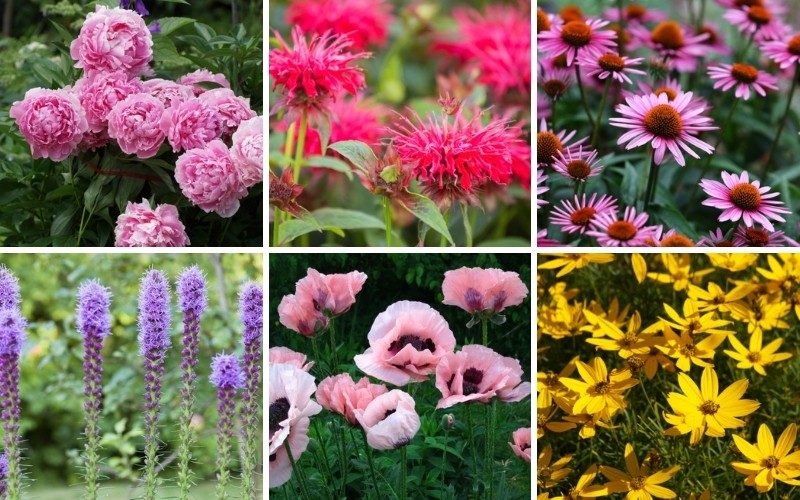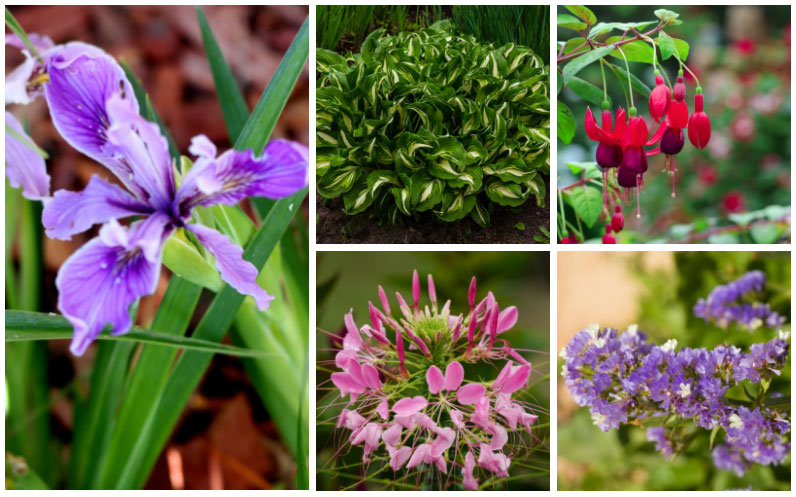
Landscaping in Indiana can be fun when you choose to use perennials. These plants that grow back every year tend to require less care than annuals and usually have fewer pest problems.
Consider these 12 perennials that are listed in no particular order for your Indiana landscape. They each look beautiful when planted in the right spot, so think about their size, light needs and other requirements to choose what will work best for you.
Black-eyed Susans

Growing up to 2-feet tall, this perennial puts on sunshine-yellow, daisy-like flowers that can be up to 3-inches wide in the spring. Each flower petal surrounds a brownish-black center. This plant also has scattered, oval-shaped leaves. During this plant’s first year, it will only put on a rosette of flowers at the top.
Hollyhock

While this plant can reach heights up to 6 feet in ideal circumstances, it usually grows to be a little over 1-foot tall. This perennial puts on light purple to white flowers on the end of a terminal stalk in the summer. It prefers a wet environment, and it loves the sun.
Hosta

You can find over 100 different varieties of this shade-loving, clump-forming perennial that is often grown for its foliage. Summer blooms are produced on long stalks that are usually clipped off before being allowed to bloom, but they are an essential food source for bees. When left alone, this plant is quite content to take care of itself, but it is easy to start a new one with a root clipping.
Daylily

One of the most versatile plants available, daylilies will grow in almost any condition. These plants that usually grow to be between 1-and-4-feet tall are heavy feeders, so do not make them compete for nutrients. You can find many different colors of daylilies with each flower lasting only one day, but the plant will continue to flower from spring to late summer.
Perennial Hibiscus

This perennial is a real showstopper because of its dinner-plate-sized blooms. Indeterminate varieties put on flowers all over the plant, but they must grow to their mature height before putting on any blooms. Determinate varieties only put on flowers on top, like icing on a cupcake. If you want a perennial that will bloom for a long time, choose indeterminate varieties.
Coneflower

If you have an area that gets a lot of sun, then coneflowers may be the perfect planting choice. The great news is that once this perennial grows to be up to 4-feet tall, it requires very little care. They produce a cone in the middle that is surrounded by petals in the summer, and you can find many different colors. Many people find the cone attractive in the fall after the petals have disappeared.
Yarrow

This perennial that grows up to 3-feet-tall can be as wide as it is tall. It produces tiny delicate flowers in clusters from early summer through early fall. Deadhead this plant throughout the growing season to keep it blooming. Depending on the variety chosen, it may produce white, pink or yellow flowers.
Columbine

There is an almost endless variety of columbine flowers with some blooming upright, like a horn, and others offering nodding flowers. These early spring bloomers are easy to take care of, and in colder climates, like Indiana’s climate, should be planted in full sun. Many have leaves that start our green or bluish-green in the spring and turn crimson in the fall, adding to the visual interest of this plant.
Jack-in-the-Pulpit

This shade-loving plant grows best in wet conditions. Jack-in-the-Pulpit blooms mid-spring and can grow up to 2-feet tall, but many plants stay much shorter. The small flowers appear on a very phallic central column. The column concludes in a sheath called a spathe, the “pulpit” that curls up and over the column. After the bloom disappears, this plant puts on green berries that birds love. These perennials can live up to 20 years.
Spiderwort

Spiderwort’s early springtime bloom can serve as a welcome reminder that spring has arrived. This clump-forming upright perennial blooms with 1-inch flowers that have three petals with each flower lasting less than a day. In the center of each flower are six bright-yellow anthers, and the base of the flower is covered in spider-like hairs. It spreads rapidly, so make sure to plant it in the right location.
Butterfly Weed

The butterfly weed may be the perfect choice for a sunny spot in your Indiana landscaping if the area drains well. This member of the milkweed family puts on bright orange flowers in the summer. After this plant blooms, then seedpods appear that are often used in flower arrangements. Growing up to 2.5-feet tall, butterfly weed is beautiful to many species of butterflies.
Artemisia

If you are looking for an aromatic herb for your landscaping, then one or more of the 300 types of artemisia is probably a great choice. Its colorful fern-like leaves pair nicely with many more colorful flowers. Most varieties grow from 1-to-4-feet-tall. This plant grows best in poor soil, and most types prefer full-sun locations.













